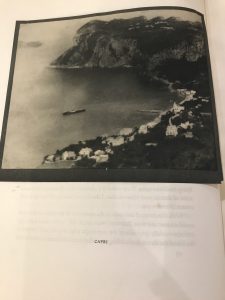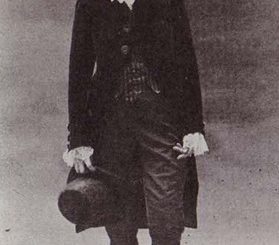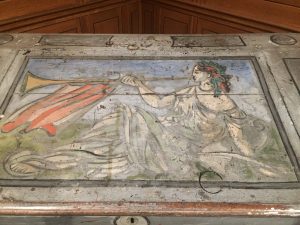H.G. Wells: When Nightmares Become Reality by Caroline F.
What originally drew me towards this object was its size. This isn’t something that one can keep in a pocket to be read on the move or in-between daily chores. The sheer scale demands the reader’s full attention; it’s nearly fifteen inches long and eleven inches wide. This means it can’t be placed on any bookshelf, either— this is something that is meant to be put on display. It’s a showpiece; it wants you to bask in its grandeur— the thick, handmade paper, the gold- stamped title, and elaborate flourishes at the beginning of each chapter. The delicate illustrations with their interweaving plant and animal imagery are similar to those seen in books of fairy tales and would not be expected in a collection of purely science-fiction short stories. If the intended message of the story was completely political, then why not publish it smaller and cheaper so that it could better reach the masses? Unless, that is, this piece was meant to be read otherwise: as a tragic love story or a foreboding fable. Is this Wells’ attempt to merge science fiction with other genres in order to appeal to a wider audience? Or was this meant to be a statement about the nature of science fiction: that, like the children’s fantasies, science fiction can also be carriers of important morals or lessons.
stamped title, and elaborate flourishes at the beginning of each chapter. The delicate illustrations with their interweaving plant and animal imagery are similar to those seen in books of fairy tales and would not be expected in a collection of purely science-fiction short stories. If the intended message of the story was completely political, then why not publish it smaller and cheaper so that it could better reach the masses? Unless, that is, this piece was meant to be read otherwise: as a tragic love story or a foreboding fable. Is this Wells’ attempt to merge science fiction with other genres in order to appeal to a wider audience? Or was this meant to be a statement about the nature of science fiction: that, like the children’s fantasies, science fiction can also be carriers of important morals or lessons.
When you look at it through that lens, the story begins to take on a new form, more similar to The Sound of Music than Star Wars. In “A Dream of Armageddon,” a man recounts a recurring dream that takes place far in the future. In these premonitions, a devastating war is brewing and he is a retired officer whom many people once looked to for leadership. Although it is inferred that he could make an impact in the war, the protagonist spends the entirety of the story trying to escape the call to war so that he can be with the woman he loves. Yes, the events and elements in the story are that of science fiction— flying warships, floating cities— but I don’t see that as the main focus. To me it’s a love story, about two tragic lovers that could not escape the modernized and destructive world around them. Perhaps the romance-centric plot is symbolic of our inner being— the part of us that desires love and peace– trying to resist a society that is constantly hungry for violence. From the eyes of someone rooted in the past, it’s both a fantastical wish and a warning.
This is also somewhat apparent in the associated image. While other illustrations of H.G. Wells’ stories show alien  ships raining terror on cities, surreal images of space and distant civilizations, or outlandish extraterrestrial species, the pictures in this book are much more tranquil— and almost eerie. The image of Capri, for example, shows a picturesque tropical beach scene, empty except for a single ship floating in the middle of the bay. It’s not an illustration, but a captured image of reality. Instead of painting a picture of the science fiction aspects of the story, the image focuses on the same serene beauty that the main character feels when he’s with his love. And, similarly to the story, this beauty is interrupted by a looming man-made homage to war and modernization.
ships raining terror on cities, surreal images of space and distant civilizations, or outlandish extraterrestrial species, the pictures in this book are much more tranquil— and almost eerie. The image of Capri, for example, shows a picturesque tropical beach scene, empty except for a single ship floating in the middle of the bay. It’s not an illustration, but a captured image of reality. Instead of painting a picture of the science fiction aspects of the story, the image focuses on the same serene beauty that the main character feels when he’s with his love. And, similarly to the story, this beauty is interrupted by a looming man-made homage to war and modernization.
The design of the book made me question a lot about Wells’ message. The main character constantly refuses to be drawn back into the war, but no matter how desperately they try to escape, they are still caught in the middle of it and killed. Not very satisfying as love stories go, is it? What if Wells was instead trying to reach a different audience— one that was wealthy enough to afford such an expensively made book, one that could relate to the protagonist: those who have the capability to affect change, and yet shirk their responsibility for their own self-indulgences. It’s all futile in the end, Wells says— unless you take action, the world will only get worse until it’s too late to change anything. The context of this story– as a dream of someone from the past— maybe suggests that this is not yet our fate. It says that we must learn from our predicted future just like we learn from the mistakes of our past. Of course, that was nearly a century ago, and the events of Capri seem to be becoming more of a reality as each year passes. It seems that sooner, rather than later, Well’s scientific fairy tales are becoming reality.










Recent Comments